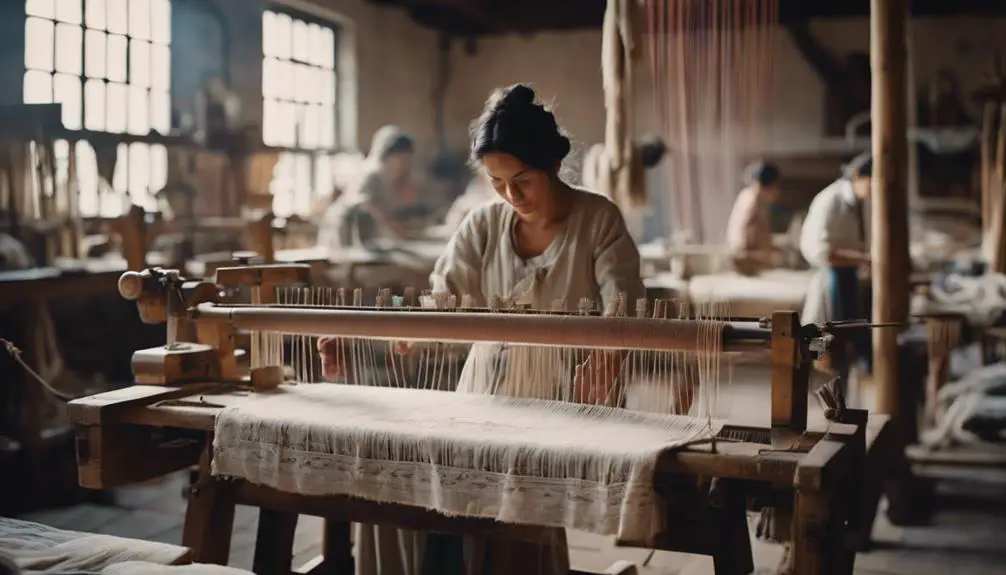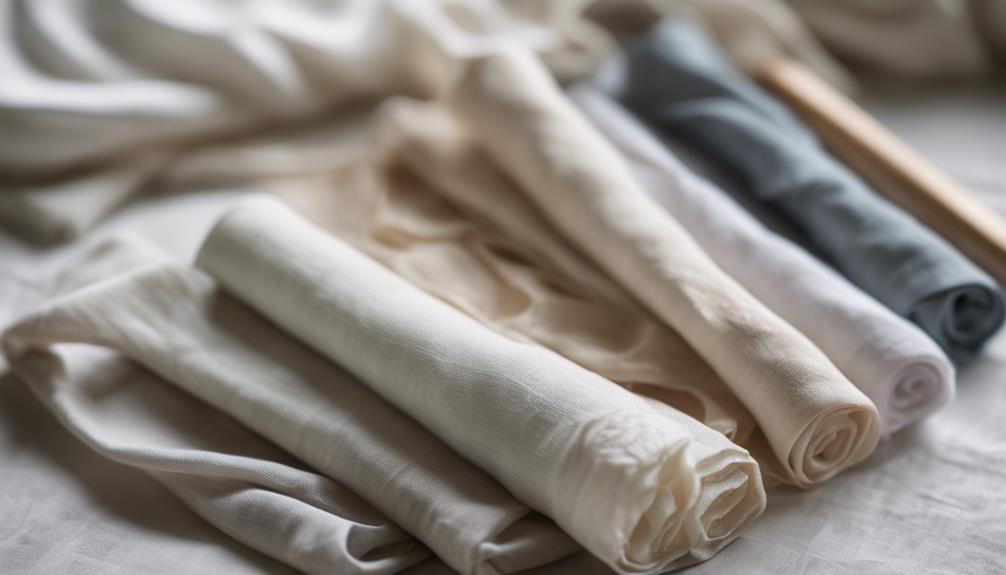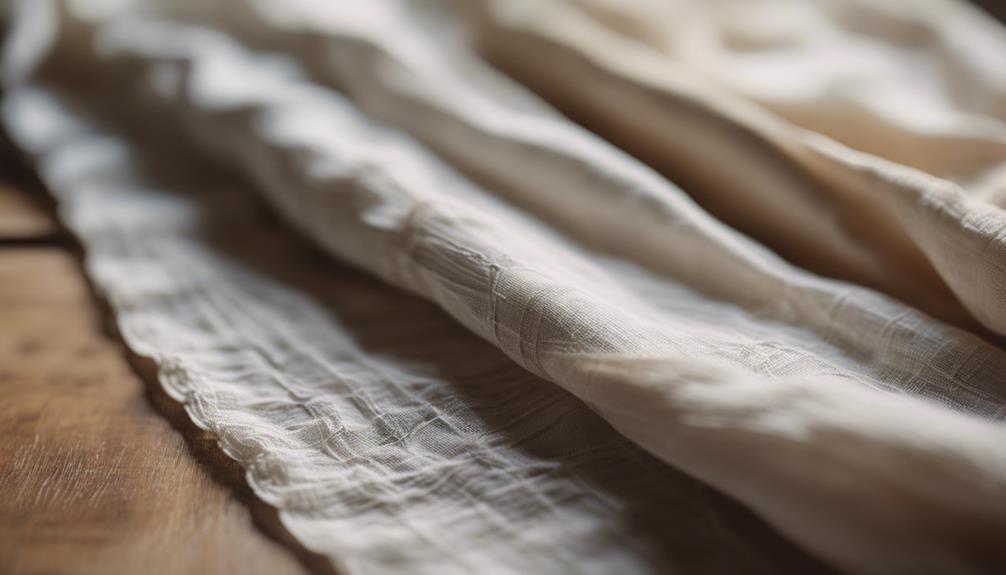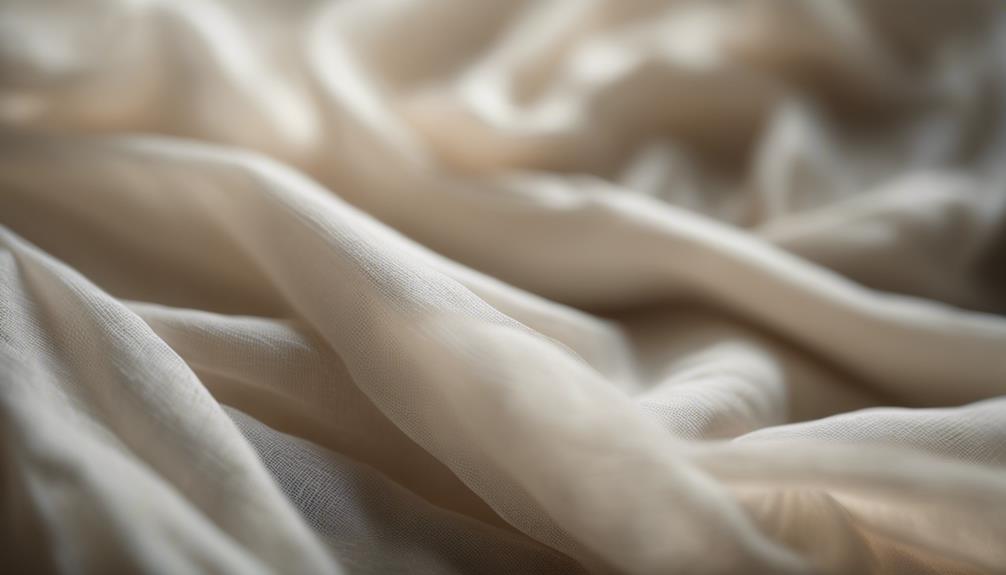To identify muslin, look for its soft, lightweight, and breathable feel. This cotton fabric has a loose weave, making it easy to recognize. Muslin typically comes in neutral shades like off-white or beige but can be dyed in various colors. You'll also notice its durability; it withstands pulling and twisting without tearing. Different types, like gauze and mull, serve unique purposes, from medical use to fashion prototyping. By checking the texture and weight, you can spot muslin quickly. If you want more insights about its applications and care, there's more to uncover.
Definition of Muslin

Muslin, a loosely woven cotton fabric, is celebrated for its soft texture and breathability, making it perfect for warm-weather clothing. This textile is crafted using a plain weave technique, which involves weaving one weft thread over and under one warp thread. As a result, you get a lightweight and durable cotton fabric that's comfortable to wear. Originating from the city of Mosul in Iraq, muslin gained prominence in ancient India, especially in the region of Dhaka.
Typically, muslin appears in neutral shades like off-white or beige, though it can be dyed in various colors and patterns to fit modern tastes. Its versatility makes it a favorite in the fashion industry for creating clothing prototypes, ensuring designers can test their ideas without committing to more expensive fabrics. Additionally, muslin finds applications in quilting, culinary settings, and even medical uses, showcasing its adaptability beyond just clothing. When you think of muslin, envision a breathable, soft textile that serves multiple purposes, from everyday garments to specialized applications. Understanding this definition helps you appreciate its value in both historical and contemporary contexts.
Key Characteristics
When exploring the key characteristics of muslin, you'll notice its loose, plain weave sets it apart, creating a lightweight and breathable fabric perfect for warm climates. Muslin fabric is typically made from cotton muslin, offering a soft feel that's comfortable against your skin. This breathable texture makes it an ideal choice for clothing and baby products, ensuring comfort in various applications.
You'll find different types of muslin, including gauze, mull, Swiss, and sheeting, each varying in weight and use. Despite its lightweight nature, muslin is known for its impressive durability, allowing it to withstand pulling and twisting without tearing, making it a reliable option for both crafting and practical use.
The fabric often appears in neutral shades, mainly off-white, but you can also find dyed variations in modern markets. This versatility in color makes it easy to incorporate muslin into various design concepts. So, whether you're sewing garments, creating decorative items, or working on baby essentials, the unique characteristics of muslin fabric will serve you well, blending comfort and functionality seamlessly.
Historical Significance

Originating in ancient India, muslin has a rich historical significance that goes beyond its fabric qualities. This lightweight, delicate muslin fabric first emerged in the region around Dhaka, now part of Bangladesh. Its exquisite craftsmanship made it highly sought after, with European traders encountering it during the 17th century and equating it to gold in value. The name "muslin" itself is derived from the Arabic word for Mosul, where this fabric was initially marketed.
Throughout history, the muslin textile industry faced challenges, particularly during British colonial rule, which exploited artisans in India and Bangladesh. Traditional manufacturing processes were disrupted, leading to a decline in high-quality muslin production, while low-quality muslin flooded the market. The significance of muslin transcended mere commerce; during the struggle for independence, Mahatma Gandhi championed khadi, a handspun and woven form of muslin, to promote local craftsmanship and resist British textile imports. This movement not only highlighted the importance of muslin fabric in cultural identity but also reinforced its place in the socio-economic landscape of India and Bangladesh. Understanding this historical significance enriches your appreciation of muslin today.
Types of Muslin
While exploring the world of muslin, you'll discover a variety of types, each with unique characteristics and uses. One of the most notable types is gauze muslin, known for its ultra-lightweight and breathable nature, making it perfect for medical dressings and kitchen filtration. If you're looking for something delicate, mull muslin might catch your eye. This lightweight cotton cloth is often used as a dress underpinning and in fashion prototyping.
Swiss muslin stands out with its sheer quality and charming embossed dots, ideal for lightweight summer clothing that combines style with ventilation. On the other hand, sheeting muslin is a thicker, coarser option, offering durability for home furnishings and clothing, providing a more substantial feel.
Common Uses

Muslin's versatility makes it a favorite across various industries. In the fashion world, this lightweight fabric type is commonly used for creating garment prototypes and patterns. Designers appreciate its breathable qualities, making it ideal for testing fits and styles.
In quilting, muslin serves as a stable backing fabric for layered designs, ensuring your stitches are secure and well-supported. When you venture into culinary settings, you'll find muslin fabric widely used for straining liquids, making cheese, and wrapping food items, thanks to its fine weave that allows for filtration while keeping solids in.
In medical environments, muslin is often utilized for bandages and surgical drapes, capitalizing on its softness and breathability to promote comfort and hygiene. Additionally, in theater and film production, the fabric is popular for backdrops and props. Its lightweight nature and ability to retain dye make it perfect for creating visually appealing settings without adding excess weight.
Whether you're sewing, cooking, or working in healthcare or the arts, muslin proves to be an invaluable resource, highlighting its adaptability across various fields.
Care Instructions
When caring for muslin, you'll want to keep a few key tips in mind to maintain its quality and appearance. First, you can either hand wash or machine wash muslin in cold water to prevent shrinkage. Using a mild detergent without bleach is essential, as it helps preserve the fabric's softness and integrity. If you're looking for muslin fabric online, verify to check the care instructions for specific recommendations.
After washing, you can choose to air-dry or tumble-dry your muslin on a low heat setting. It dries quickly and retains its shape well, so you shouldn't have any issues. Avoid hot water washes and high dryer settings, as these can greatly shrink the fabric and reduce its lifespan.
If you notice wrinkles in your muslin, you might need to iron muslin to restore its smooth texture. Set your iron to a medium setting to prevent scorching. By following these care instructions, you'll keep your muslin in good condition for years to come, allowing you to enjoy its many uses without worry.
Comparison With Other Fabrics

Understanding muslin's unique qualities helps in comparing it with other fabrics. Muslin fabrics are primarily made of 100% cotton, featuring a loose, open weave that sets them apart from tighter weaves found in poplin or sateen. This distinctive weaving makes muslin more breathable, ideal for summer clothing and baby products, where comfort and breathability are essential.
When you consider different weights of muslin types, you'll notice that they remain lightweight compared to heavier fabrics like canvas or denim, which can feel cumbersome. While fabrics like rayon or linen may vary in texture and drape, muslin tends to be softer and more inviting to the touch.
Another key difference lies in durability. Muslin can withstand frequent washing and repeated use, unlike delicate fabrics like silk, which require special care. Additionally, while some muslin may include synthetic fiber blends, pure muslin maintains its natural feel and breathability. By recognizing these characteristics, you can easily identify muslin and appreciate its versatility against other fabric options.
Frequently Asked Questions
How to Tell if Fabric Is Muslin?
To tell if fabric is muslin, feel its soft texture and check for a plain, solid color. Look for breathability and a non-stretchy quality, which are key characteristics that distinguish muslin from other fabrics.
What Does Muslin Fabric Look Like?
Muslin fabric looks lightweight and breathable, often appearing slightly sheer. You'll notice its soft, smooth texture in neutral shades like off-white or beige. It can vary in thickness, affecting its drape and overall aesthetic.
What Does Muslin Fabric Feel Like?
When you touch muslin fabric, you'll notice its soft, lightweight texture that feels gentle against your skin. It's slightly crisp yet smooth, flowing gracefully without being heavy, making it incredibly comfortable to wear.
What Is the Characteristic of Muslin Fabric?
Muslin fabric's characteristic features include a loose, open weave that promotes breathability, a soft texture for comfort, and typically neutral shades like beige or off-white, making it perfect for various lightweight clothing and baby products.





Thank you for your sharing. I am worried that I lack creative ideas. It is your article that makes me full of hope. Thank you. But, I have a question, can you help me?
Your article helped me a lot, is there any more related content? Thanks!